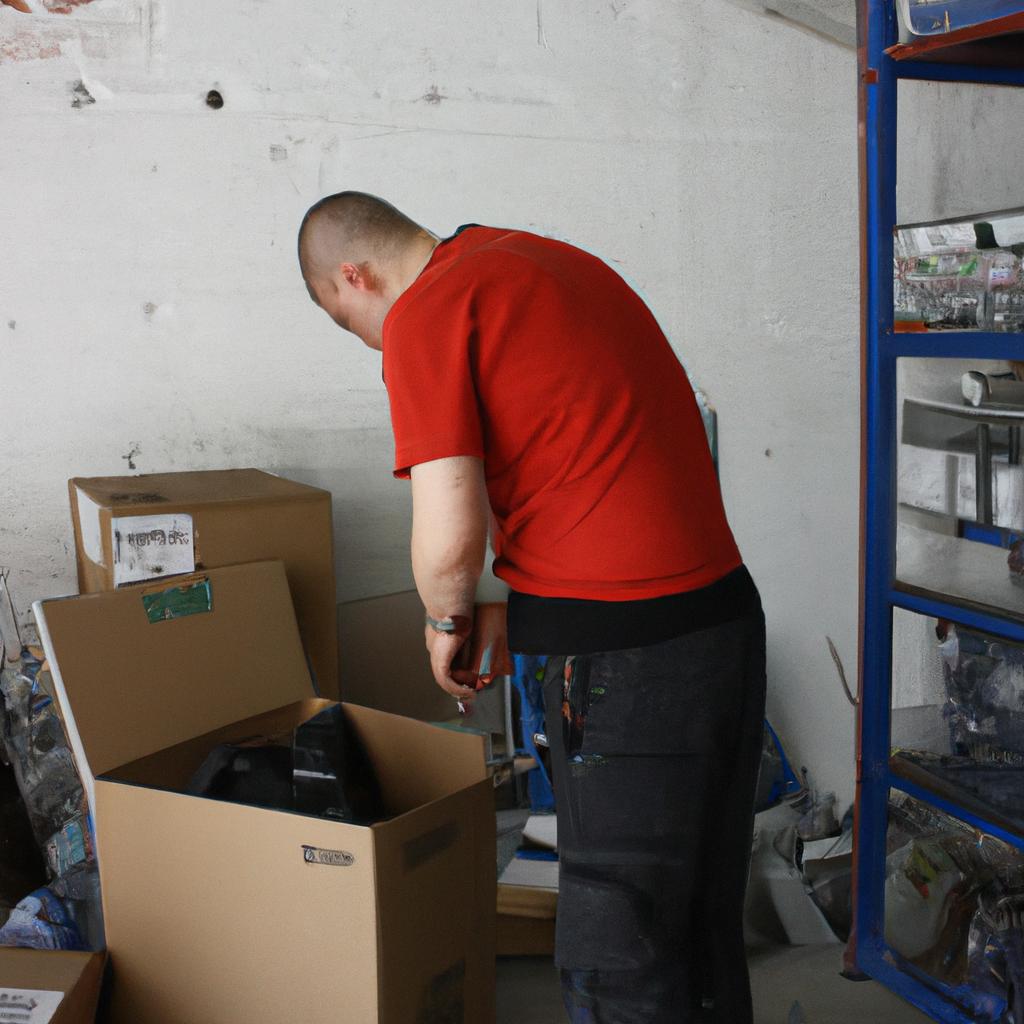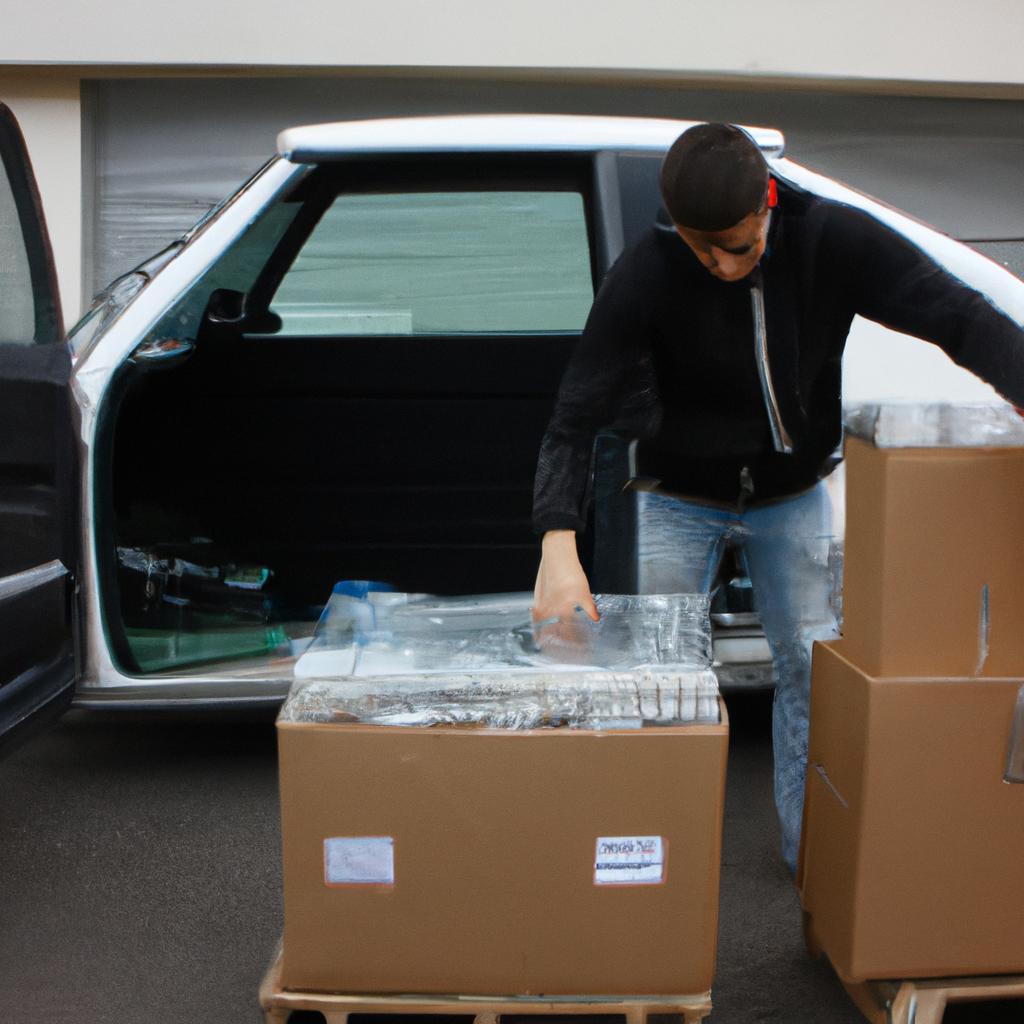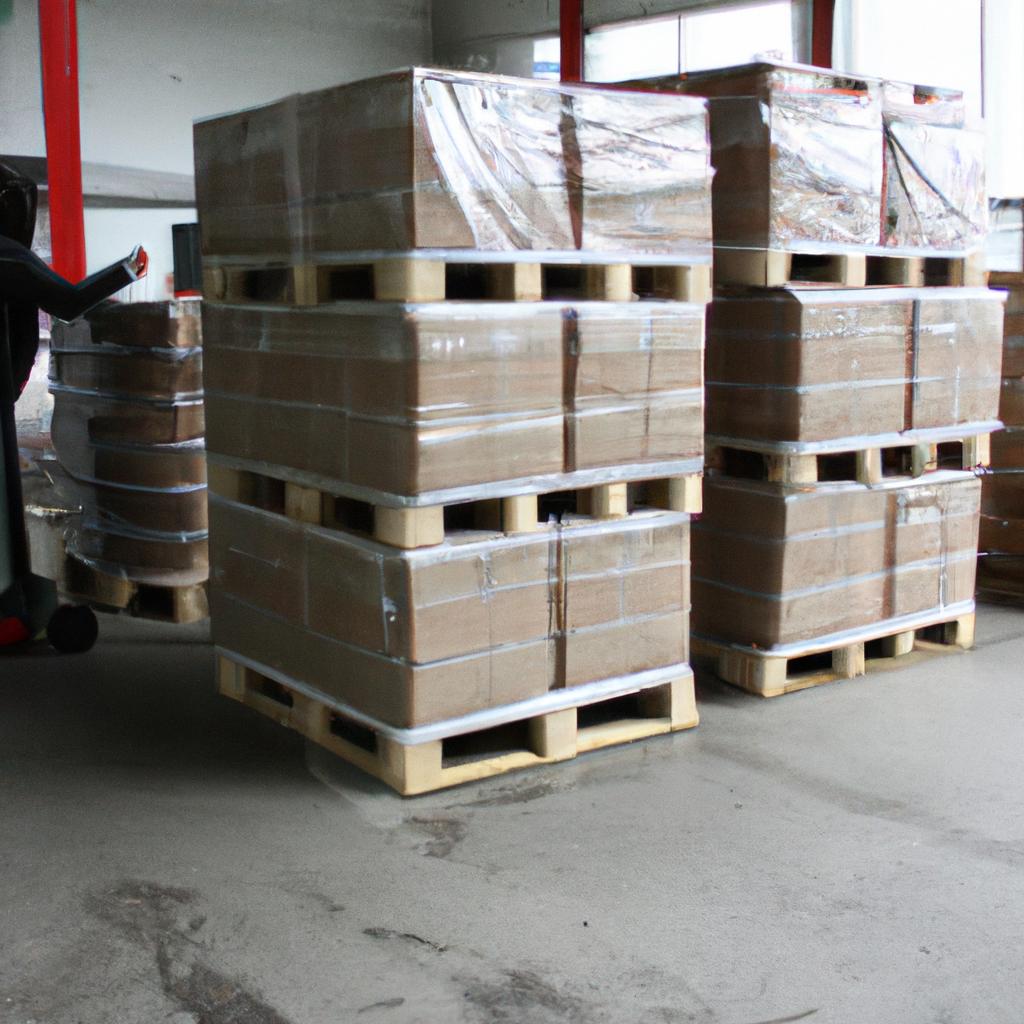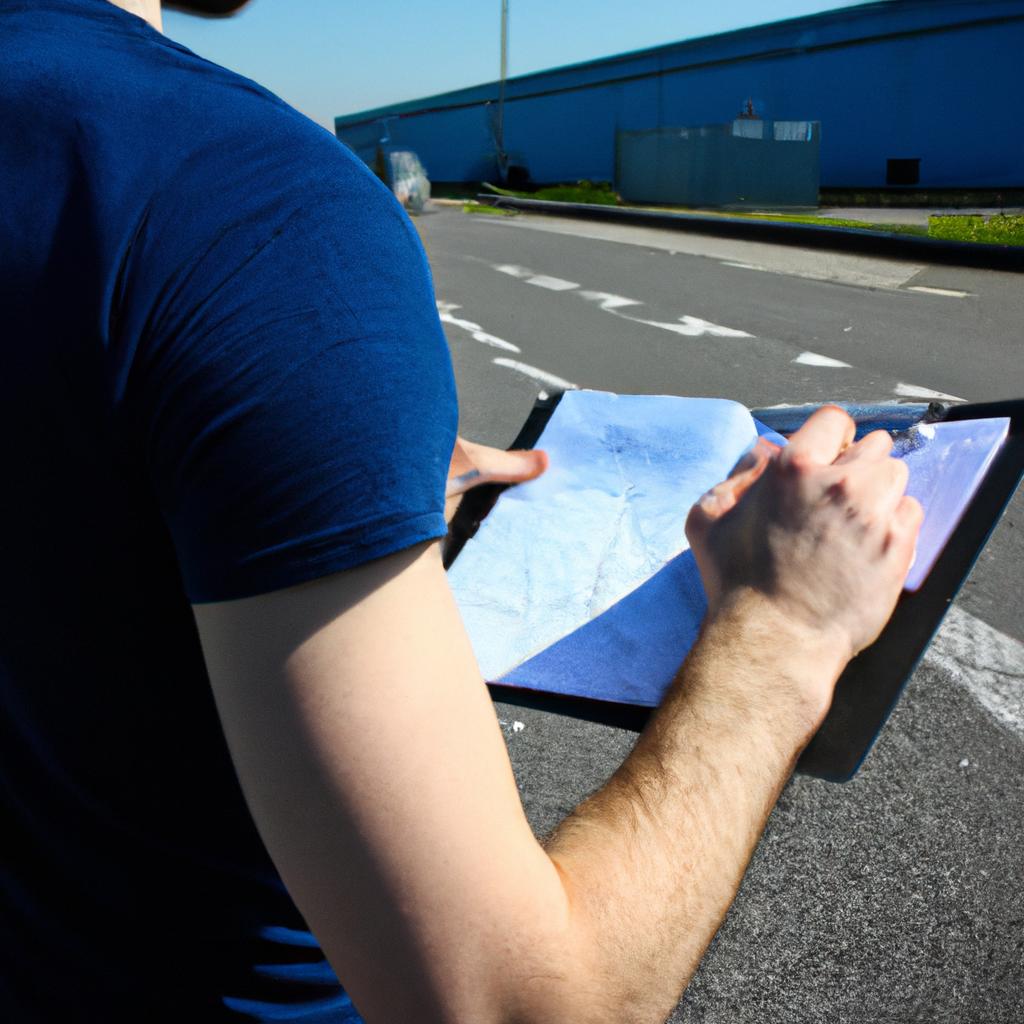The transportation and logistics industry plays a crucial role in the movement of goods from manufacturers to consumers. However, sometimes products need to be returned due to various reasons such as defects, damages during transit, or customer dissatisfaction. This is where the Reverse Logistics process comes into play. In this article, we will explore the RMA (Return Merchandise Authorization) process in transportation and logistics, focusing on its importance and how it facilitates the efficient management of product returns.
To better understand the significance of the RMA process in transportation and logistics, let us consider an example scenario. Imagine a consumer purchasing a high-end electronic device online but receiving a faulty unit upon delivery. The RMA process allows the consumer to initiate a return request by contacting the seller or manufacturer, who then authorizes the return by issuing an RMA number. This unique identifier enables effective tracking and accountability throughout all stages of reverse logistics operations. By examining this case study and delving deeper into the intricacies of reverse logistics within transportation systems, we can gain valuable insights into how companies handle product returns efficiently while minimizing costs and improving customer satisfaction.
Reverse logistics encompasses several activities beyond simply handling returns. It involves processes such as inspection, repair or refurbishment, repackaging, recycling, disposal, inventory management, and even resale of returned products. These activities are crucial for managing the flow of returned goods and ensuring that they are properly handled and disposed of according to legal and environmental regulations.
In the case of our example scenario, once the faulty electronic device is returned with the authorized RMA number, it undergoes a thorough inspection to determine the nature and extent of the defect. Depending on the outcome, it may be repaired or refurbished to bring it back to working condition. If repair is not feasible or cost-effective, the device may be recycled or disposed of in an environmentally friendly manner.
The reverse logistics process also involves repackaging returned products, especially if they have been damaged during transit or handling. Proper repackaging ensures that the product is protected and ready for reshipment or resale.
Inventory management is another critical aspect of reverse logistics. Returned products need to be accurately tracked within a company’s inventory system to prevent loss, theft, or misplacement. Effective inventory management allows companies to identify patterns and trends in returns, which can lead to improvements in product quality, packaging, or customer service.
Furthermore, some companies may choose to resell returned products as refurbished or open-box items at reduced prices. This not only recoups some of the losses from returns but also provides customers with opportunities for discounted purchases.
Overall, reverse logistics plays a vital role in transportation and logistics by facilitating efficient management of product returns. It helps reduce costs associated with returns while improving customer satisfaction through prompt handling and resolution of issues. By understanding the intricacies of reverse logistics processes like RMA management, companies can optimize their operations and enhance their overall supply chain performance.
Definition of RMA process
Definition of RMA Process
The Returns Merchandise Authorization (RMA) process is a crucial component in the field of transportation and logistics, ensuring effective management of product returns. This process involves various steps that are followed when customers wish to return or exchange products due to reasons such as defects, damages, or dissatisfaction. To illustrate its significance, let us consider a hypothetical scenario: A customer purchases an electronic device online but discovers upon delivery that it is faulty. In this case, the RMA process would facilitate the smooth return and replacement of the defective item.
Understanding the RMA process requires familiarization with its key components. Firstly, customers must initiate their request by contacting the company’s customer service department or submitting an online form. The next step entails evaluation and verification of eligibility for return based on specific criteria established by each company, such as adherence to warranty terms or expiration dates. Once approved, organizations issue an RMA number to uniquely identify each return transaction efficiently.
To shed light on how intricate the RMA process can be, here is a markdown-formatted bullet point list highlighting some challenges faced:
- Complexity: Managing multiple channels of communication from customers seeking returns can lead to difficulties in effectively coordinating all aspects.
-
Logistical hurdles: Coordinating reverse supply chain activities necessitates careful planning and coordination among multiple stakeholders involved in shipping, receiving, inspecting, repairing/replacing items,
and restocking inventory. - Customer satisfaction: Timely resolution becomes vital for maintaining positive relationships with customers while addressing their concerns promptly.
- Cost implications: Reverse logistics processes involve expenses related to inspection, repair/refurbishment costs if applicable; hence efficient handling minimizes financial impact on companies.
In addition to these complexities, another essential element within the RMA process is tracking and reporting. Organizations often employ advanced tracking systems that allow them to monitor returned goods at every stage – from initiation until final disposition – providing valuable data for analysis and process improvement.
Understanding the definition and challenges associated with the RMA process lays a solid foundation to comprehend its importance in transportation and logistics. The subsequent section will delve into this significance, exploring how effective management of returns can improve customer satisfaction, reduce operational costs, and enhance overall supply chain performance.
Importance of RMA process in transportation and logistics
In the previous section, we discussed the definition of the RMA (Return Merchandise Authorization) process. Now, let us delve deeper into the importance of this process in transportation and logistics by exploring reverse logistics.
Reverse logistics refers to the management of product returns from customers back to the manufacturer or distributor. It involves various activities such as receiving returned goods, evaluating their condition, repairing or replacing them if necessary, and ensuring proper disposal or resale. To better understand its significance, let’s consider an example:
Imagine a scenario where a customer purchases a laptop online but receives it with a damaged screen due to mishandling during transit. The customer initiates a return request through the RMA process, informing the company about the issue. Here are some key reasons why implementing an efficient RMA process is crucial for transportation and logistics companies:
- Customer satisfaction: A smooth and hassle-free RMA process enhances customer satisfaction by providing timely responses and resolutions to their concerns.
- Cost reduction: Effective reverse logistics can lead to cost savings by identifying faulty products early on, minimizing repair expenses, reducing inventory write-offs, and optimizing resource allocation.
- Environmental sustainability: By incorporating environmentally friendly practices like recycling or refurbishing returned items instead of disposing of them, companies contribute positively towards sustainable development.
- Brand reputation: A well-managed RMA process ensures that customers perceive a brand as reliable and trustworthy when handling product returns professionally and resolving issues promptly.
To further illustrate these points visually, here is a table showcasing how different aspects of transportation and logistics benefit from an effective RMA process:
| Aspect | Benefits |
|---|---|
| Customer Satisfaction | Timely response to return requests |
| Efficient resolution of customer complaints | |
| Cost Reduction | Early identification of faulty products |
| Minimization of repair expenses | |
| Environmental Sustainability | Recycling or refurbishing returned items |
| Reducing waste through proper disposal | |
| Brand Reputation | Perception of reliability and trustworthiness |
Incorporating a well-structured RMA process in transportation and logistics brings numerous advantages. It not only ensures customer satisfaction but also helps companies reduce costs, promote environmental sustainability, and enhance their brand reputation.
Transitioning to the subsequent section about “Steps involved in the RMA process,” we will explore how these processes are implemented to achieve efficient reverse logistics.
Steps involved in the RMA process
Transitioning from the importance of the RMA process in transportation and logistics, it is vital to understand the steps involved in implementing an effective reverse logistics system. To illustrate this further, let’s consider a hypothetical scenario where a consumer purchases a defective product online and initiates a return through the RMA process.
The first step in the RMA process is for the customer to contact the retailer or manufacturer to request authorization for returning the faulty item. In our example case, once the customer reaches out to the company’s customer service department, they provide all relevant information regarding their purchase, including order details and reasons for return. This initial communication sets off a chain of events that ultimately leads to resolving the issue efficiently.
Once authorized, either electronically or via physical documentation such as an RMA number or label, the next step involves packaging and shipping back the defective product. In our scenario, after receiving approval for return, detailed instructions are provided to guide customers on how to safely package and ship back their purchased item using appropriate carriers and services. It is crucial at this stage to ensure proper handling during transit to mitigate any potential damages.
Upon receipt of the returned goods by the retailer or manufacturer’s designated facility, thorough inspection takes place before determining whether repair, replacement, or refund is warranted. Our hypothetical situation continues with technicians examining every aspect of the returned product within predefined parameters set by quality control standards. Based on these assessments, decisions are made regarding further actions required – be it repairing minor defects discovered during inspection or replacing entirely non-functional items.
To grasp better how reverse logistics can impact both businesses and consumers emotionally throughout this process, consider these key points:
- Frustration: Customers experience frustration when encountering issues with products they have invested time and money into.
- Relief: The moment when authorization for return is granted brings relief since progress toward resolution has been made.
- Trust: Smooth and efficient handling of the RMA process helps establish trust between customers and businesses.
- Satisfaction: When a satisfactory solution is provided promptly, it leaves customers feeling satisfied with their overall experience.
In summary, understanding the steps involved in the RMA process allows us to appreciate its significance within transportation and logistics. By following these sequential stages – from customer communication to inspection and resolution – companies can effectively manage returns, ensuring both consumer satisfaction and operational efficiency. As we delve deeper into this topic, let’s explore some of the challenges faced in implementing an effective RMA process.
Challenges faced in implementing RMA process
Implementing a Reverse Merchandise Authorization (RMA) process in the transportation and logistics industry can be a complex undertaking. While it offers numerous benefits, such as reducing costs and improving customer satisfaction, there are several challenges that organizations may encounter during its implementation. This section will explore some of these challenges and provide insights into addressing them effectively.
Example Case Study:
To better understand the challenges faced in implementing an RMA process, let us consider the case study of Company X, a global e-commerce retailer. Company X decided to streamline their returns management by introducing an RMA process across their supply chain network. However, they encountered various obstacles along the way, which serve as valuable lessons for other organizations aiming to implement similar processes.
Challenges Encountered:
- Lack of standardized procedures: One significant challenge faced by Company X was the absence of standardized procedures for handling RMAs at different stages of the supply chain. As a result, there were inconsistencies in how returns were processed, leading to delays and inefficiencies.
- Integration issues with existing systems: Another challenge was integrating the new RMA system with their existing transportation and warehouse management systems. The lack of compatibility between these systems caused data discrepancies and hindered smooth communication among various stakeholders involved.
- Limited visibility throughout the process: Company X found it challenging to maintain visibility over returned products’ status due to inadequate tracking mechanisms. This resulted in difficulties identifying bottlenecks or addressing problems promptly.
- Managing customer expectations: Lastly, managing customer expectations regarding return policies and timelines posed a challenge for Company X. Ensuring clear communication about return conditions, refund processing timeframes, and overall transparency became crucial areas requiring attention.
| Challenges | Impact | Solution |
|---|---|---|
| Lack of standardized procedures | Inconsistent handling of returns | Develop comprehensive RMA guidelines |
| Integration issues with existing systems | Data discrepancies and communication problems | Invest in compatible software solutions |
| Limited visibility throughout the process | Difficulty identifying bottlenecks | Implement robust tracking mechanisms |
| Managing customer expectations | Decreased customer satisfaction | Provide clear communication and transparency |
In conclusion, implementing an RMA process in transportation and logistics can face various challenges. Companies like Company X have experienced difficulties due to lack of standardized procedures, integration issues with existing systems, limited visibility, and managing customer expectations. However, these challenges can be effectively addressed through the development of comprehensive guidelines, investment in compatible software solutions, implementation of robust tracking mechanisms, and providing clear communication and transparency.
By overcoming these obstacles, organizations can unlock the benefits of an efficient RMA process which will be explored in the subsequent section on “Benefits of an Efficient RMA Process”.
Benefits of an efficient RMA process
Challenges faced in implementing the RMA process within the transportation and logistics industry highlight the need for efficient reverse logistics solutions. These challenges can range from issues with product identification and inventory management to ensuring timely customer refunds or replacements. To better understand these obstacles, let’s consider an example of a global e-commerce company that handles returns on a daily basis.
Imagine a scenario where this e-commerce giant faces difficulties in accurately identifying returned products due to incomplete or damaged packaging. This leads to delays in processing returns, making it challenging to provide customers with prompt refunds or exchanges. Additionally, managing large volumes of returned items poses a significant challenge in terms of space allocation and organization within their warehouses.
To overcome such hurdles, companies must focus on improving key aspects of the RMA process. A well-implemented RMA process not only ensures effective management of return shipments but also offers several benefits that contribute to overall operational efficiency:
- Reduced costs: An efficient RMA process allows organizations to identify trends and patterns related to product returns, enabling them to take proactive measures in reducing future returns. By minimizing unnecessary shipping expenses and optimizing inventory levels, businesses can significantly reduce costs associated with reverse logistics.
- Enhanced customer satisfaction: A streamlined RMA process enables faster resolution of customer concerns, leading to improved satisfaction rates. Customers appreciate hassle-free returns and prompt replacements/refunds, which ultimately strengthens brand loyalty.
- Sustainable practices: Implementing an eco-friendly approach through proper disposal or recycling of returned products aligns businesses with sustainable practices. This not only helps protect the environment but also enhances corporate social responsibility efforts.
- Competitive advantage: Companies that excel at their RMA processes gain a competitive edge over their peers by differentiating themselves as reliable partners who prioritize customer service excellence.
To further illustrate successful implementation strategies for the RMA process, we will now delve into case studies showcasing how various organizations have effectively addressed these challenges while maximizing operational efficiencies.
Case studies showcasing successful RMA process implementation will demonstrate how companies have navigated the complexities of reverse logistics, providing valuable insights into best practices and strategies that can be adopted by organizations within the transportation and logistics industry. By analyzing these real-world examples, we can gain a deeper understanding of the practical implications of an efficient RMA process and its impact on overall business success.
Case studies showcasing successful RMA process implementation
Transitioning from the previous section on the benefits of an efficient RMA process, it is important to explore case studies that showcase successful implementation of such processes in transportation and logistics. By examining real-world examples, we can gain insights into best practices and learn how organizations have effectively managed their reverse logistics operations.
One notable example is Company X, a leading e-commerce retailer specializing in electronics. Facing increasing customer returns due to product defects or buyer’s remorse, Company X decided to revamp its RMA process. They implemented several key strategies:
- Streamlined Returns Management: Company X established a centralized returns center equipped with advanced technology for efficient processing and tracking of returned items. This enabled them to minimize manual errors and reduce processing times.
- Enhanced Communication Channels: Recognizing the importance of effective communication with customers during the return process, Company X improved their support systems by providing multiple channels for submitting return requests and obtaining updates on the status of their returns.
- Automated Inspection and Refurbishment: To streamline the assessment of returned products, Company X invested in automated inspection equipment. This allowed them to quickly identify whether a returned item could be refurbished or needed replacement, minimizing turnaround times.
- Advanced Data Analytics: Leveraging data analytics tools, Company X gained valuable insights into patterns related to returns. This enabled them to proactively address common issues, improve product quality control measures, and optimize inventory management.
In addition to this specific case study, there are other instances where companies have successfully implemented efficient RMA processes. These success stories highlight some common themes:
| Company | Industry | Key Strategies Implemented |
|---|---|---|
| Organization A | Retail | – Dedicated team for managing RMAs |
| – Real-time inventory monitoring | ||
| – Collaborative partnerships with suppliers | ||
| Organization B | Manufacturing | – Detailed return policies and procedures |
| – Transparent communication with customers | ||
| – Continuous improvement through feedback | ||
| Organization C | Automotive | – Reverse logistics network optimization |
| – Customer-centric return experience | ||
| – Efficient handling of core returns |
These case studies demonstrate the potential benefits that an efficient RMA process can bring to organizations operating in transportation and logistics. By incorporating streamlined processes, improved communication channels, advanced technology, and data analytics, companies can enhance customer satisfaction, reduce costs associated with returns, and optimize their overall reverse logistics operations.
Through the analysis of these successful implementations, it becomes evident that a well-designed RMA process is crucial for any organization dealing with product returns. With careful planning and adoption of best practices from established case studies, businesses in the transportation and logistics sector can effectively manage their reverse logistics operations while improving customer experiences.








